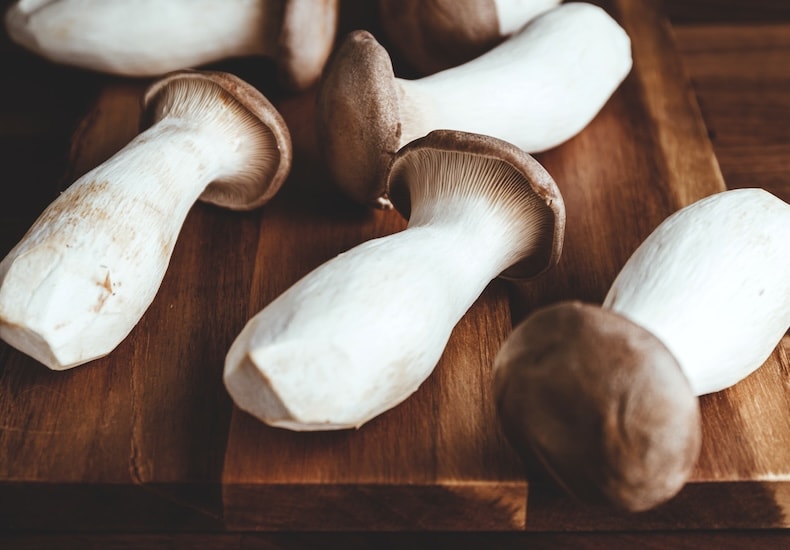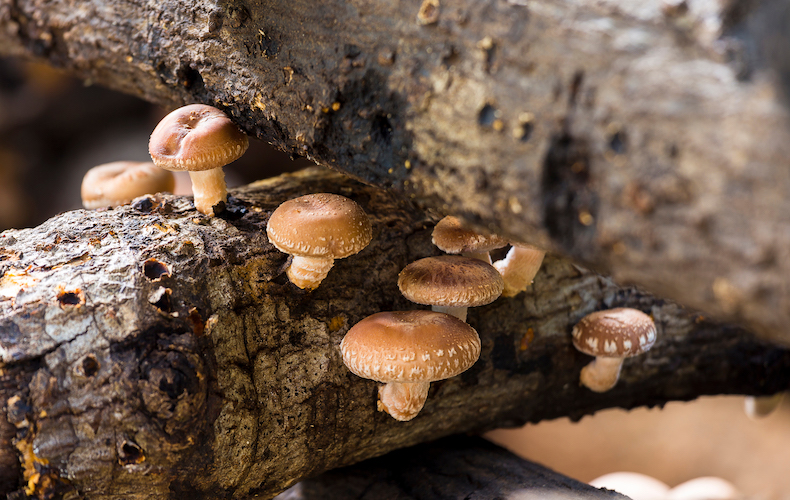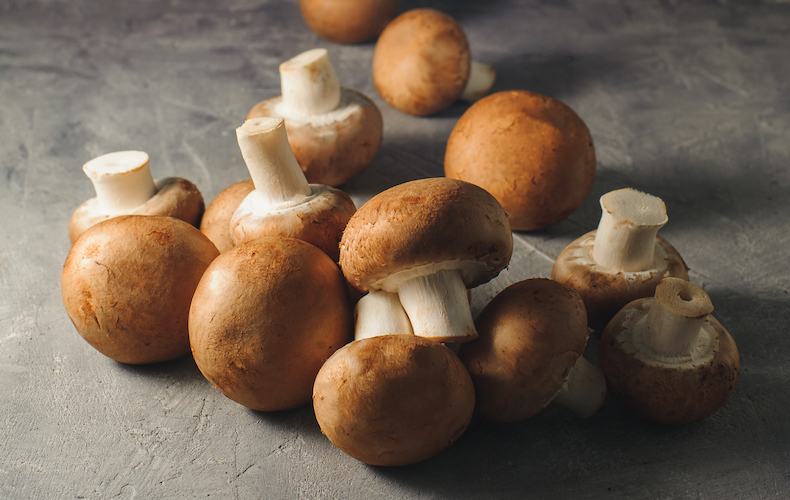How to grow mushrooms

Cut your grocery bill down by growing your own mushrooms
Image: Mushroom Windowsill Kit King Oyster from Thompson & Morgan
For something a bit different, why not grow your own mushrooms at home? Not as complicated as you might think, our complete mushroom growing kits provide step-by-step instructions along with everything you need. Here’s a quick guide to growing your own mushrooms using logs or easy-grow kits.
Why you should grow your own mushrooms

Yellow oyster mushrooms are a rare variety and aren't usually commercially available
Image: Mushroom Windowsill Kit - Yellow Oyster from Thompson & Morgan
Mushrooms are virtually fat and calorie-free and are packed full of vitamins and minerals to keep you feeling on top form. They’re also a very rich source of protein and therefore perfect for vegans and vegetarians.
Although mushrooms do grow in the wild, it’s much safer to grow your own than risk foraging. You’ll know exactly which varieties you’re eating and you can enjoy watching the process as they fruit.
Best types of mushrooms to grow at home
- Oyster mushrooms (Pleurotus ostreatus) - With a thick, soft texture and a subtle flavour, these mushrooms can be eaten raw or cooked and are often used in Oriental dishes.
- Shiitake mushrooms (Lentinula edodes) - Cultivated and nurtured in Japan for more than a thousand years, Shiitake mushrooms are a sought-after ingredient for many Oriental dishes. A good accompaniment to meats, stir-fries and heavy sauces.
- Lions' Mane (Hericium erinaceus) - Grown in China and Japan for hundreds of years, these mushrooms are renowned for their medicinal benefits. This unusual variety has a taste likened to lobster when cooked with butter, but can be eaten boiled, grilled or as a healthy addition to many other dishes.
- Chestnut (Agaricus bisporus) - A traditional variety packed with flavour - add to risottos, stews and soups.
- White Cap mushrooms (Agaricus bisporus) - the most commonly available mushroom, this variety also contains some of the highest levels of vitamins and minerals.
How to grow mushrooms on logs

'Shiitake' mushrooms grow very successfully on logs
Image: Thompson & Morgan
One of the simplest ways to grow mushrooms is on logs. Wooden dowels, impregnated with mushroom mycelium (mushroom spawn), are inserted into hardwood logs where they produce crops of fruit several times a year for about five years or so.
Although dowels are available all year, the logs needed to grow the mushrooms should be cut from healthy trees during the dormant season (between leaf fall in autumn and early spring). Store your dowels in the fridge or a cool, dark, well-ventilated place until ready to use, and plant them in the log no longer than 6 weeks after it has been cut to prevent contamination from unwanted fungi.
It’s best to use hardwood logs for mushroom growing - oak, beech, birch, hazel, willow etc. Sycamore, apple and ash are not recommended. To support 10-15 dowels, your log should have a diameter of about 10-15cm and a length of 50cm. Keep the logs shaded from direct sunlight and strong winds to prevent them drying out before use. If you don't have suitable logs for mushroom growing you could ask local tree surgeons, council parks departments or forest managers if they have anything suitable.
- Drill holes about 15cm (6 inches) apart down the length of the log.
- Rows should be spaced 7.5cm (3 inches) apart.
- Insert the dowels and tap them in so they’re flush with the log surface.
- Seal the inoculation holes, any damaged bark and any cut branch-ends with a layer of wax but don’t wax the log-ends as some moisture must be allowed in.
- Position the logs in a shady wooded area or wrap them in black polythene and bury them under ground. You could also place them under evergreen shrubs.
- Keep an eye on your logs and if there are signs of significant cracking soak the logs in water for 2 days to thoroughly wet the bark.
- Mushroom mycelium takes between 6 and 18 months to colonise a log. You may see the mycelium appear as a 'V' shape at the end. Once logs are fully colonised they can be moved to a warm, sheltered, moist area in dappled shade where they will begin to fruit.
- Growing mushrooms in woodland is ideal to meet these requirements. Lean the logs with one end on a brick, rock or another log - don’t lie them flat on the ground.
Each species differs and will only fruit when environmental conditions are right. Small, white nodes will appear from the inoculation points on the log and these will develop into mushrooms within a week. Maintain humidity and moisture levels during this time and don’t move the log. To harvest your mushrooms, grasp them at the base of the stem and twist them away from the log. Logs will continue to fruit for up to 4 weeks. After several months the mycelium will regenerate and produce another crop. Logs can be productive for four to six years.
How to grow mushrooms from spawn

Using spawn, you can grow mushrooms throughout the year
Image: Mushroom 'Brown Cap Button' (Portabella) from Thompson & Morgan
You can grow mushrooms inside using grain spawn and composted manure. Using this same traditional method, your mushrooms can be grown outdoors, although you’re at the mercy of the weather when you can’t control the conditions yourself.
Growing mushrooms from spawn: outdoors
To grow your mushrooms outdoors, sow the spawn into neglected areas of lawn or around compost heaps between spring and August. Soil rich in organic matter will give the best results.
- Lift 25cm (10 inch) square pieces of turf to a depth of 4cm, with each square set about 60cm (24in) apart.
- Loosen the soil beneath the turf squares with a garden fork, adding extra organic matter such as well-rotted manure or garden compost if the soil is poor.
- Don’t use chemical fertilisers as mushrooms won’t grow in these conditions.
- Spread the mushroom spawn thinly over the soil surface and lightly mix to 1cm deep.
- Replace the turf squares firmly and keep the soil moist, but not waterlogged.
Growing mushrooms from spawn: indoors
To grow your mushrooms indoors, you’ll need a deep tray or box and an even temperature of around 16C (50F). It shouldn’t fall below 10C or rise above 20C.
- Fill a box with 25cm of compost made from well prepared horse manure. (Use well-rotted manure from a garden centre, or prepare your own.)
- Put your mushroom boxes in a cellar, shed or garden frame. They can be grown in dark or light conditions, but not direct sunlight.
- Remember that mushrooms require an even temperature of around 16C (50F) to grow.
- Tightly pack mushroom beds with prepared compost and scatter the spawn across the surface, mixing it to 2 or 3 inches deep before covering with damp newspaper.
- After 3 weeks, the compost will be colonised by mycelium which will look like white threads. Remove the newspaper at this point and cover the compost with a 2.5cm (1") layer of casing, mixed from 50% garden soil, 50% peat and a few handfuls of lime. Alternatively you could also use 50% compost (peat-free is fine) and 50% chalk or lime. Lime is necessary as mushrooms prefer alkaline growing conditions.
- Keep the casing layer moist but not wet - use a fine rose watering can or a mister.
- Mushrooms will begin to develop 3 to 5 weeks after adding the casing layer.
- Maintain a moist, humid atmosphere as the mushrooms develop.
- Harvest mushrooms by twisting the cap until it comes away from the compost. You should receive flushes of growth every 10 days or so.
We hope we’ve inspired you to try growing your own mushrooms at home. Whether you choose to colonise a log or grow them in a tray in your cellar, fresh crops of homegrown mushrooms are a fantastic way to add a nutrient-rich boost to family mealtimes.
Return to
Other quick links

Written by: Sue Sanderson
Plants and gardens have always been a big part of my life. I can remember helping my Dad to prick out seedlings, even before I could see over the top of the potting bench. As an adult, I trained at Writtle College where I received my degree, BSc. (Hons) Horticulture. After working in a specialist plantsman's nursery, and later, as a consulting arboriculturalist, I joined Thompson & Morgan in 2008. Initially looking after the grounds and coordinating the plant trials, I now support the web team offering horticultural advice online.Sign Up For Exclusive Special Offers




© 2025 Thompson & Morgan. All rights reserved. A division of Branded Garden Products Limited.
Sign up for exclusive offers!



